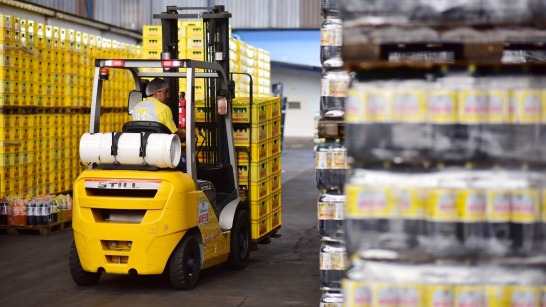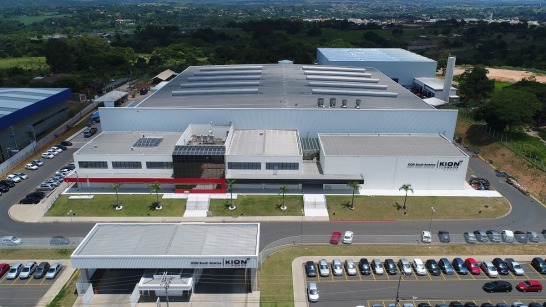In any industry, it is important that pallets are transported without any accidents occurring. Yet there are few sectors in which careful stacking is as vital as in the beverage industry. This is because the goods being transported are fragile in the truest sense of the word. The industry already possesses a lot of expertise in this area, but there is still a real appetite for innovation. “In recent years, demand for safety concepts has continued to rise,” says Jordi Monlleó Llurba, Planning, Projects and Innovation Manager at Alfil Logistics, a Spanish logistics firm that specializes in the beverage industry and other areas. “We believe that safety features such as warning lights should be viewed as integral to forklift trucks – not just as accessories,” he adds.
Handling volumes and time pressure on the rise
Like many other sectors, the beverage industry has seen an efficiency revolution in recent years. In the era of e-commerce and retail developments, customers and dealers expect increasingly speedy deliveries. Precision and care must be reconciled with a need for maximum processing speed. In the face of conflicting requirements like these, systems such as precision-controlled hydrostatic drives really come into their own, as seamless acceleration and braking offer real added value in this environment. The same is true of assistance systems: “We are aware that industry giants like InBev and Coca Cola in particular are very safety-conscious and are willing to invest in innovation,” says Hannes Schöbel, Global Lead Key Account Manager at Linde Material Handling. Item diversity is rising significantly while handling volumes and time pressure are also increasing. Until just a few years ago, it was not uncommon to see identical beverage crates in ten-high stacks in warehouses. This made both order picking and loading comparatively simple, but today a specific crate may need to be accessed from behind another. Plus, since the beverage industry is part of the food sector, some beverages have expiry dates. An additional challenge lies in supplying items to customers as freshly as possible in the appropriate sequence. As a result, there is increased demand for efficient transportation of smaller, more specialized orders on mixed pallets.
Microbreweries and mass production
Such is the diversity of this industry that there are no dominant trends – in fact, most developments are accompanied by a contradictory trend. While ‘individualization’ is an irrefutable phenomenon, evident, for instance, in the triumphant rise of microbreweries, craft beers, seasonal beverages and a constant stream of new varieties produced by famous brands, in other areas, an even stronger trend towards mass production is apparent, spurred on by new forms of automated production. The packaging industry has also incentivized a revival in half-liter bottles, fuelled largely by a new ‘to go’ culture, with item volumes virtually doubling compared to liter bottles.
The same picture emerges in the warehouses of beverage producers, dealers and logistics experts – on one hand, pallets are becoming narrower in order to cater for individually picked orders and also due to increasingly tightly-packed high-bay warehouses. On the other, ultra-large pallets are extremely common as these significantly increase efficiency. This is another of the industry’s idiosyncrasies – each batch often sees very high loads handled using such means as multiple pallet clamps. As a result, highly loaded pallets or beverage crates are common. “Most beverage companies use 4.5 to 5-tonne forklifts equipped with clamps for two or even four pallets,” comments Schöbel.
Warehouses becoming taller
Previously, when beverage producers or logistics experts expanded their warehouses, they generally increased the width. In recent years, however, many companies have increased the height of their warehouses due to rising lease prices in Europe and America. Consequently, the industry is faced with the challenge of transporting heavy loads easily, efficiently and safely from ever higher locations. To meet these requirements, vehicles that are easy to operate and equipped with assistance systems are required.
For logistics experts like Alfil, one of the consequences of all this is increased demand for flexible rental fleets capable of responding to whatever situation arises, whether peak demand or special requirements. “The beverage industry is experiencing cost pressure,” comments Monlleó. This has a knock-on effect on logistics: “Our orders are invoiced strictly according to the number of pallets.” The drive for greater efficiency and increasing handling capacity has led the industry to adopt more automated or semi-automated logistics solutions. Warehouse management systems are also a hot topic due to supply chains changing. As a result of trends such as e-commerce and direct collection, it is suddenly possible – even necessary – to deliver directly to end customers.
Potential savings through the drive
Demand for automated guided vehicles (AGVs) is also increasing. In a recent article, the industry portal bevindustry.com highlighted the flexibility and safety of new generation AGVs. In contrast to earlier models, these are equipped with a variety of assistance systems but no longer require navigation infrastructure that is expensive to install – features that are particularly attractive in the beverage industry. The industry is also hoping to increase its efficiency through drive technology. Combustion engines are actually relatively common in the beverage industry, “we are, however, also seeing a trend towards electric forklift trucks in the sector,” says Schöbel.
In his view, this is partly due to end-consumers: “Sustainability is very important to brand image.” Financial considerations are also partly responsible, since innovations such as lithium-ion batteries enable a higher handling rate than lead acid batteries due to swift interim charging. “Minimal charging times and larger natural gas tanks will be increasingly important to us going forward,” reveals logistics expert Monlleó.
One thing is clear: beverage warehouses continue to be see a lot of diversity and conflicting challenges, with bottles, cans and kegs needing to be transported quickly, safely, cost-effectively and sustainably. Whether for selective mixed pallets or uniform multiple pallets, the beverage industry still needs the flexible forklift to manage these extremely diverse requirements.




_image_546x307.jpg)